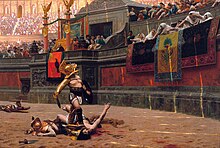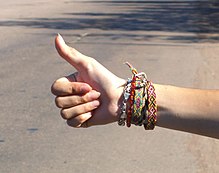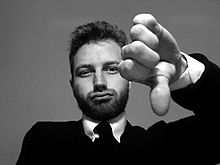Thumb signal

A thumb signal, usually described as a thumbs-up or thumbs-down, is a common hand gesture achieved by a closed fist held with the thumb extended upward or downward in approval or disapproval, respectively. These gestures have become metaphors in Template:Lang-en, regardless of whether the gesture was actually made. The term itself is an Anglo-Saxon word indicating the measure of a clenched hand with the thumb extended.
Origins
The source of the gesture is obscure, but a number of origins have been proposed.
Late Middle Ages, Europe
It has been suggested that 'thumbs up' was a signal from English archers preparing for battle that all is well with their bow and they are ready to fight. Before use, the Fistmele (or the "brace height") was checked, that being the distance between the string and the bow on an English Longbow. This fistmele should be about 7 inches (18 cm), which is about the same as a fist with thumb extended. The term Fistmele is a Saxon word that refers to that measurement.[1]
Opposable thumbs
Carleton S. Coon, having observed Barbary apes in Gibraltar using the gesture, hypothesised in the anthropological classic The Story of Man that it is a mutual celebration of having opposable thumbs.[2] Critics[who?] have suggested, however, that the apes may be simply imitating humans.
Ancient Rome

The Latin phrase pollice verso is used in the context of gladiatorial combat for a hand gesture used by Ancient Roman crowds to pass judgment on a defeated gladiator. However, the precise type of gesture described by the phrase pollice verso and its meaning are unclear in the historical and literary record.[3][4][5]
In modern popular culture, it is assumed that "thumbs down" was the signal that a defeated gladiator should be condemned to death; "thumbs up", that he should be spared. The latter view was popularized by a widely reproduced painting by the 19th-century artist Jean-Léon Gérôme, whose Pollice Verso (usually known in English as "Thumbs Down") depicts a triumphant gladiator looking up into the stands for the verdict of the crowd.[citation needed]
"Now they give shows of their own. Thumbs up! Thumbs down! And the killers, spare or slay, and then go back to concessions for private privies" from Juvenal's Against the City of Rome (ca. 110–127 B.C.)
Medieval
Desmond Morris in Gestures: Their Origins and Distribution traces the practice back to a medieval custom used to seal business transactions. Over time, the mere sight of an upraised thumb came to symbolize harmony and kind feelings.[clarification needed] For an example in the 17th century see the Diego Velázquez painting The Lunch.
World War II

The gesture's popularization in America is generally attributed to the practices of World War II pilots, who used the thumbs up to communicate with ground crews prior to take-off. This custom may have originated with the China-based Flying Tigers, who were among the first American flyers involved in World War II. The appreciative Chinese would say ”挺好的“ ("ting hao de"), meaning "very good," and gesture with a thumbs up, which in Chinese means "you're number one." High officials in the Chinese government see it as a sign of respect. Any person from China will recognize this numerical gesture, and it can be seen in movies and photos of the era, though this has not been verified in print by American Volunteer Group (AVG) pilots.
During World War II, pilots on US aircraft carriers adopted the thumbs up gesture to alert the deck crew that they were ready to go and that the wheel chocks could be removed. On modern US carriers, certain deck crew hold a thumb up to signal to the pilot and control tower that their station is OK for take-off.
The use of the specific term "thumbs up" to describe the gesture can be found on a series of postcards produced by the Exhibit Supply Company of Chicago, Illinois during World War II. These cards were designed to be mailed to soldiers overseas.
American GIs are reputed to have picked up on the thumb gesture and spread it throughout Europe as they marched toward Berlin."[6] Combat pilots in the US and around the world still use this gesture.
According to Luís da Câmara Cascudo,[7] Brazilians have adopted the "thumbs up" from watching American pilots based in northern Brazil during World War II.
International usage

The thumbs up signal has a generally positive connotation in English-speaking countries. However, its perceived meaning varies significantly from culture to culture.[8]
The sign has a pejorative meaning in parts of West Africa, Iran, and Greece according to Roger E. Axtell's book Gestures: The Do's and Taboos of Body Language Around the World.[9] In practice, most Greeks nowadays recognise the positive connotation of the sign due to international exposure. Any perceived pejorative meaning of the past is lost in contemporary use. Despite that, the sign is still very rarely used by native Greeks for its positive meaning (and never for the pejorative).
In Germany, France, and Hungary, the gesture can simply indicate the number one, in the right context.
In Finland, the gesture means "good luck".
In India the gesture is accepted. If the hand is wagged from side to side in a reverse-pendulum like movement while doing a thumbs up, it means "won't work" or "disagree".[citation needed] The thumbs up gesture is used on the logo of Thums Up soda.
In the United States, American Sign Language users use the thumbs up wiggled modestly left and right to indicate the number ten (10).[10] When held stationary and thrust toward another person the meaning is "yourself".[11] When lifted up by the other palm, the meaning is "help".[12]
On the Internet, and most particularly at the Facebook social media site, the thumbs up gesture is shown as an icon and is associated with the term "like"—which within that context means to follow or subscribe to the page, posts, or profile of another individual or company. See Like button.
Context-specific usage
This section needs additional citations for verification. (January 2017) |


More recently, these gestures are associated with movie reviews, having been popularized by critics Gene Siskel and Roger Ebert[13] on their televised review show Siskel & Ebert — the thumb up meaning a positive opinion of a film; the thumb down meaning a negative one. The trademarked phrase "two thumbs up", originally meaning a positive review from both reviewers, has come to be used as an indication of very high quality or unanimity of praise.

By extension from the movie review usage,[14] many websites (including Facebook) allow users to approve or disapprove of items, such as comments in a forum, products in a store, or even other people's reviews of movies, books, products, etc., by choosing to click either a thumbs-up or thumbs-down button. In the aggregate, this serves as an evaluation system. Other users may then see the total number of thumbs up and thumbs down given to an item, or may simply see the number which is produced by subtracting thumbs down from thumbs up. (In the latter case, an item which has received exactly ten of each would read as having a rating of zero, rather than one of +10/-10.) Often, users may view a list of items in order of popularity, as ranked by this metric.
Hitchhikers in the West traditionally use a thumbs up gesture to solicit rides from oncoming vehicles, although in this presentation the arm is generally outstretched with the palm and closed fingers facing the motorist. The gesture is also usually performed with the hand nearest the motorist.[15]
In scuba diving, the thumbs-up gesture is a specific diving signal given underwater, in which the diver indicates that he or she is about to stop his or her dive and ascend. This occasionally causes confusion in new divers, who might automatically gesture thumbs-up when trying to indicate approval — actually indicating a desire to stop diving and to ascend. The diving signal for approval is the A-ok sign.[16]
In basketball, when a held ball occurs, an official will jerk both thumbs in the air, signalling that a jump ball is in order.
In baseball, umpires will sometimes jerk a thumbs-up over their shoulder as an "out" signal
Amusement park rides such as roller coasters are usually cleared for departure using a thumbs-up signal from the crew after inspection that all safety precautions have been taken.
The Indian cola brand Thums Up, now owned by The Coca-Cola Company is named after this symbol, and uses it as its logo.
Unicode
Unicode reserves 👍 or U+1F44D symbol and 👎 or U+1F44E symbol for the thumbs up and thumbs down gestures, respectively. A reversed (left-facing) thumbs up gesture is encoded at U+1F592.
Other Encodings
Other symbols are -b (right hand) and d- (left hand).[citation needed] Various instant messaging services use (y) and (n) as a shortcut for thumbs up and thumbs down emoji.[17][18]
See also
References
- ^ Hagar, George (1841). Of the Shaft, Ancient and Modern. The Archery Library: Hansard. pp. Chapter 10.
- ^ Carlton S. Coon: "The Story of Man" (1954)
- ^ "James Grout: The Gladiator and the Thumb, part of the Encyclopædia Romana". Penelope.uchicago.edu. Retrieved 2013-07-03.
- ^ "Desmond Morris, Peter Collett, Peter Marsh and Marie O'Shaughnessy, 1979 Webified by Bernd Wechner: Gestures: Their Origin and Meanings, The Thumb Up". Bernd.wechner.info. Retrieved 2013-07-03.
- ^ "Did The Romans Turn Thumbs Down On Gladiators?". News.ku.edu. 1997-09-29. Retrieved 2013-07-03.
- ^ Onion, Rebecca. "Slate: What Does a "Thumbs Up" Mean in Iraq?". Slate.MSN.com. Retrieved 2013-07-03.
- ^ Toledo, Roberto Pompeu de (March 14, 2007). "Uma paixão dos brasileiros". Veja Magazine (1999): 110.
- ^ Strazny, Philipp (2005). Encyclopedia of Linguistics: M-Z. Fitzroy Dearborn. p. 812. ISBN 1-57958-451-9.
- ^ Koerner, Brendan I. (March 28, 2003). "What Does a "Thumbs Up" Mean in Iraq?". Slate.
- ^ "Ten". ASL Browser. Michigan State University Communication Technology Laboratory.
- ^ "Yourself". ASL Browser. Michigan State University Communication Technology Laboratory.
- ^ "Help". ASL Browser. Michigan State University Communication Technology Laboratory.
- ^ CBS (2 January 2011). "Roger Ebert's New Voice" – via YouTube.
- ^ Pulver, Andrew (23 June 2016). "'Thumbs down': female critics vastly outnumbered by male counterparts – new study". The Guardian. Retrieved 2 May 2017.
- ^ Wickman, Forrest. "Digit To Ride". slate.com. Retrieved 2 May 2017.
- ^ Feather, Lauren. "Hand signals are the most effective means of communication underwater. Do you know which are the most common?". scubadiverlife.com. Retrieved 2 May 2017.
- ^ "List of emoticons in MSN messenger".
- ^ "Thumb Up / Like Sign Facebook Chat Emoticons Shortcut Keys Code Dislike button". November 3, 2011.
